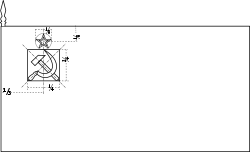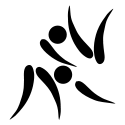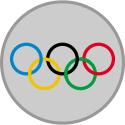Olympische Sommerspiele 1964/Judo
| Ringen bei den Olympischen Sommerspielen 1964 | |
|---|---|
 | |
 | |
| Information | |
| Austragungsort | |
| Wettkampfstätte | Nippon Budōkan |
| Nationen | 27 |
| Athleten | 72 (72 Männer) |
| Datum | 20.–23. Oktober 1964 |
| Entscheidungen | 4 |
Bei den XVIII. Olympischen Spielen 1964 in Tokio fanden vier Judo-Wettbewerbe für Männer statt. Austragungsort war der eigens zu diesem Zweck erbaute Nippon Budōkan im Bezirk Chiyoda. Judo stand zum ersten Mal überhaupt auf dem olympischen Programm, bis zur nächsten Austragung vergingen aber noch acht Jahre.
Bilanz

Medaillenspiegel
| Platz | Land | Gesamt | |||
|---|---|---|---|---|---|
| 1 | 3 | 1 | – | 4 | |
| 2 | 1 | – | – | 1 | |
| 3 | – | 1 | 1 | 2 | |
| 4 | – | 1 | – | 1 | |
| – | 1 | – | 1 | ||
| 6 | – | – | 4 | 4 | |
| 7 | – | – | 1 | 1 | |
| – | – | 1 | 1 | ||
| – | – | 1 | 1 |
Medaillengewinner
| Konkurrenz | Gold | Silber | Bronze |
|---|---|---|---|
| Leichtgewicht | |||
| Halbmittelgewicht | |||
| Schwergewicht | |||
| Offene Klasse |
Ergebnisse
Leichtgewicht (bis 68 kg)
| Platz | Land | Sportler |
|---|---|---|
| 1 | Takehide Nakatani | |
| 2 | Eric Hänni | |
| 3 | Ārons Bogoļubovs | |
| Oleg Stepanow | ||
| 5 | Chang Won-ku | |
| Paul Maruyama | ||
| Park Chung-sam | ||
| Gerhard Zotter | ||
| 9 | Karl Reisinger | |
| 19 | Matthias Schießleder |

Datum: 20. Oktober 1964
25 Teilnehmer aus 18 Ländern
Halbmittelgewicht (bis 80 kg)
| Platz | Land | Sportler |
|---|---|---|
| 1 | Isao Okano | |
| 2 | Wolfgang Hofmann | |
| 3 | James Bregman | |
| Kim Eui-tae | ||
| 5 | Lionel Grossain | |
| Rodolfo Pérez | ||
| Lhofei Shiozawa | ||
| Peter Snijders | ||
| 9 | Alfred Redl |
Datum: 21. Oktober 1964
25 Teilnehmer aus 20 Ländern
Schwergewicht (über 80 kg)
| Platz | Land | Sportler |
|---|---|---|
| 1 | Isao Inokuma | |
| 2 | Douglas Rogers | |
| 3 | Ansor Kiknadse | |
| Parnaos Tschikwiladse | ||
| 5 | Kim Jong-dai | |
| 6 | Michel Casella | |
| Chang Chung-huei | ||
| Job Gouweleeuw | ||
| George Harris | ||
| Nicola Tempesta | ||
| 11 | Herbert Niemann |

Datum: 22. Oktober 1964
14 Teilnehmer aus 12 Ländern
Offene Klasse
| Platz | Land | Sportler |
|---|---|---|
| 1 | Anton Geesink | |
| 2 | Akio Kaminaga | |
| 3 | Theodore Boronovskis | |
| Klaus Glahn | ||
| 5 | John Ryan | |
| 6 | Ben Nighthorse Campbell | |
| 7 | Thomas Ong | |
| 8 | Ali Hachicha | |
| Alan Petherbridge |

Datum: 23. Oktober 1964
9 Teilnehmer aus 9 Ländern
Weblinks
- Judo bei den Olympischen Sommerspielen 1964 in der Datenbank von Sports-Reference (englisch; archiviert vom Original)
- Offizielle Ergebnisse der Sommerspiele 1964 (PDF, 14,5 MB)
Auf dieser Seite verwendete Medien
Pictograms of Olympic sports - Judo. This is unofficial sample picture. Images of official Olympic pictograms for the 1948 Summer Olympics and all Summer Olympics since 1964 can be found in corresponding Official Reports.
Variant version of a flag of Japan, used between January 27, 1870 and August 13, 1999 (aspect ratio 7:10).
Variant version of a flag of Japan, used between January 27, 1870 and August 13, 1999 (aspect ratio 7:10).
Autor/Urheber: maix¿?, Lizenz: CC BY-SA 2.5
A gold medal with the olympic rings inside
Autor/Urheber: maix¿?, Lizenz: CC BY-SA 2.5
A silver medal with the olympic rings inside
Autor/Urheber: maix¿?, Lizenz: CC BY-SA 2.5
A bronze medal with the olympic rings inside
The Canadian Red Ensign, the national flag of Canada from 1957 to 1965. (see: the Canadian Red Ensign on the Register of Arms, Flags and Badges)
Die quadratische Nationalfahne der Schweiz, in transparentem rechteckigem (2:3) Feld.
(c) I, Cmapm, CC BY-SA 3.0
The flag of the Soviet Union (1955-1991) using a darker shade of red.

(c) I, Cmapm, CC BY-SA 3.0
The flag of the Soviet Union (1955-1991) using a darker shade of red.

Flag of Australia, when congruence with this colour chart is required (i.e. when a "less bright" version is needed).
See Flag of Australia.svg for main file information.Flagge Österreichs mit dem Rot in den österreichischen Staatsfarben, das offiziell beim österreichischen Bundesheer in der Charakteristik „Pantone 032 C“ angeordnet war (seit Mai 2018 angeordnet in der Charakteristik „Pantone 186 C“).
Flag of Italy from 1946 to 2003, when exact colors were specified.
Man sagt, dass der grüne Teil die Mehrheit der katholischen Einwohner des Landes repräsentiert, der orange Teil die Minderheit der protestantischen, und die weiße Mitte den Frieden und die Harmonie zwischen beiden.
Flagge des Vereinigten Königreichs in der Proportion 3:5, ausschließlich an Land verwendet. Auf See beträgt das richtige Verhältnis 1:2.
Flagge des Vereinigten Königreichs in der Proportion 3:5, ausschließlich an Land verwendet. Auf See beträgt das richtige Verhältnis 1:2.
Olympic Rings without "rims" (gaps between the rings), As used, eg. in the logos of the 2008 and 2016 Olympics. The colour scheme applied here was specified in 2023 guidelines.
Olympic Rings without "rims" (gaps between the rings), As used, eg. in the logos of the 2008 and 2016 Olympics. The colour scheme applied here was specified in 2023 guidelines.
Flag of Tunisia until 1999.
The flag of Brazil from 1960 to 1968 with 22 stars.
Autor/Urheber: Morio, Lizenz: CC BY-SA 3.0
Nippon Budokan
Die Olympiaflagge der gesamtdeutschen Mannschaft von 1960 und 1964, sowie beider deutschen Mannschaften 1968.
Left-right: Doug Rogers, Isao Inokuma, Parnaoz Chikviladze, Anzor Kiknadze at the Tokyo Olympics. Tokyo, October 1964
Logo der olympischen Sommerspiele 1964 in Tokyo
Flag of South Korea (1949-1984)
The Canadian Red Ensign, the national flag of Canada from 1957 to 1965. (see: the Canadian Red Ensign on the Register of Arms, Flags and Badges)
Eric Hänni, Takehide Nakatani, Oleg Stepanov, 1964 Olympics
Judo, 1964 Olympics, left-right: Akio Kaminaga, Anton Geesink, Ted Boronovskis, Klaus Glahn




























